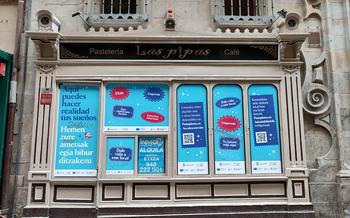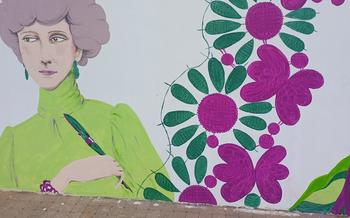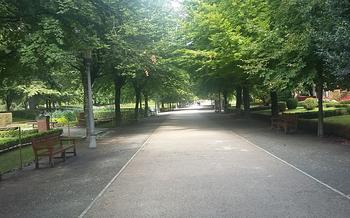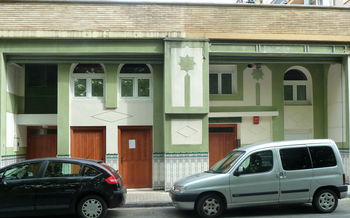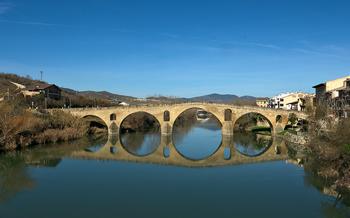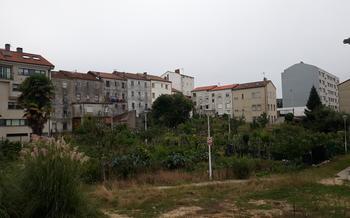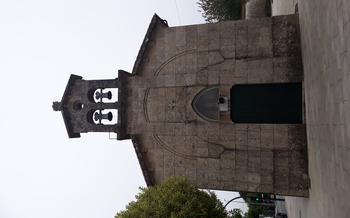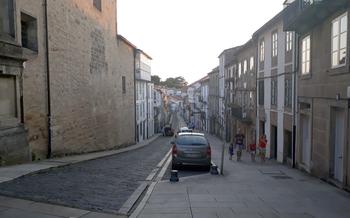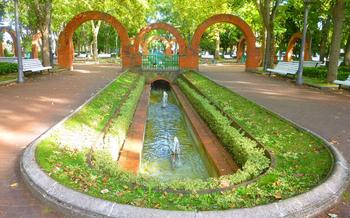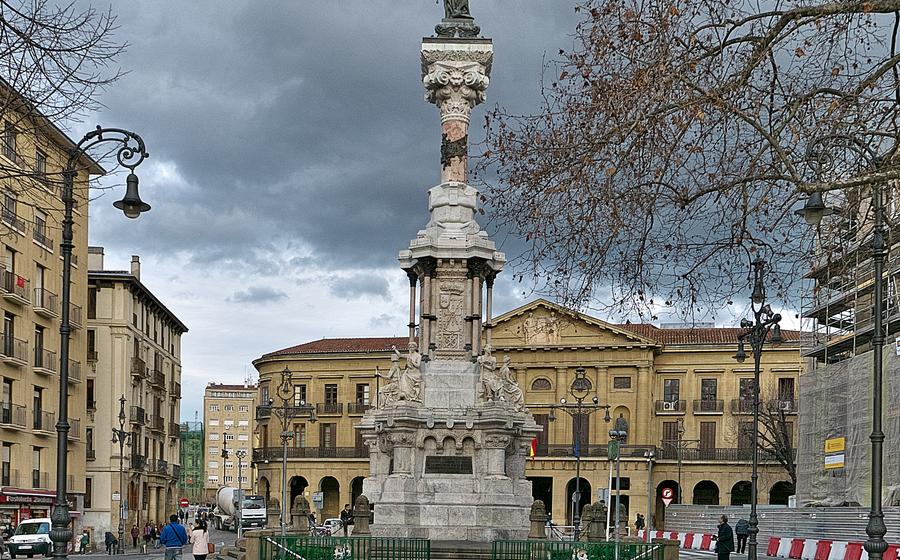
San Pedro de la Rúa Church in Estella
- History and Architectural Style
- Marvelous Facade: A Masterpiece of Romanesque Art
- Captivating Interior: A Blend of Styles
- Exploring the Church's Highlights
- A Journey Through Time: The Church's History
- Pilgrims' Haven: A Place of Rest and Reflection
- Tips for Visiting the Church
- Practical Information: Planning Your Visit
- Suggested Itineraries: Exploring Estella's Treasures
- Nearby Attractions: Enriching Your Experience
History and Architectural Style
Nestled in the heart of Estella, the San Pedro de la Rúa Church stands as a testament to the town's rich history and religious heritage. Its origins can be traced back to the 11th century, when it was initially built as a Romanesque church. Over the centuries, the church underwent several expansions and modifications, incorporating Gothic and Renaissance influences into its architectural style.
The result is a harmonious blend of architectural elements, reflecting the transition from Romanesque simplicity to the more elaborate styles that followed. The church's exterior features a magnificent facade with intricate carvings and sculptures, showcasing biblical scenes and symbolic representations. The Puerta del Perdón (Door of Forgiveness) is particularly noteworthy for its exquisite craftsmanship and historical significance.
Marvelous Facade: A Masterpiece of Romanesque Art
The facade of the San Pedro de la Rúa Church is a captivating sight, showcasing the exceptional artistry and craftsmanship of the Romanesque period. Intricate carvings and sculptures adorn the exterior, depicting scenes from the Bible and representing religious symbols. The Puerta del Perdón (Door of Forgiveness), the church's main entrance, is particularly impressive, featuring a semi-circular arch adorned with intricate carvings that tell stories of faith and redemption. The door is a testament to the skill and devotion of medieval artisans, who created a masterpiece that continues to inspire awe and admiration.
Captivating Interior: A Blend of Styles
Inside the San Pedro de la Rúa Church, visitors are greeted by a captivating blend of architectural styles. The Gothic influence is evident in the pointed arches, ribbed vaults, and elegant stained glass windows that adorn the interior. These elements create a sense of height and grandeur, drawing the eye upwards towards the intricate details of the ceiling.
The Renaissance style is also present in the church's interior, particularly in the elaborate altarpieces and religious artworks that decorate the walls and niches. These artworks, often depicting biblical scenes and figures, are exquisitely crafted with vibrant colors and intricate details, showcasing the skill and artistry of the Renaissance masters.
The combination of Gothic and Renaissance elements creates a visually stunning and harmonious interior that reflects the rich artistic heritage of the San Pedro de la Rúa Church. Whether admiring the intricate carvings of the choir stalls, gazing upon the radiant stained glass windows, or marveling at the grandeur of the altarpieces, visitors are sure to be captivated by the beauty and artistry that fills this sacred space.
Exploring the Church's Highlights
Beyond its captivating facade and intriguing history, the San Pedro de la Rúa Church boasts a treasure trove of artistic and architectural highlights that beckon exploration. Step into the serene interior, and you'll be greeted by a harmonious blend of Gothic and Renaissance influences, each contributing to the church's unique character.
One of the most striking features of the interior is the collection of stunning stained glass windows. Drenched in vibrant hues, these windows depict scenes from the Bible, adding a mystical and ethereal glow to the sacred space. As sunlight streams through the intricate glass panels, the church transforms into a kaleidoscope of colors, creating an awe-inspiring spectacle.
Admire the elaborate altarpieces that adorn the church, each a testament to the skill and devotion of past artisans. These intricate works of art, carved from wood and adorned with gold leaf, depict religious scenes and figures with remarkable detail, capturing the essence of faith and spirituality.
Don't miss the impressive 16th-century organ, a masterpiece of craftsmanship and a testament to the church's musical heritage. With its ornate carvings and gilded pipes, the organ is a sight to behold, adding grandeur and solemnity to the church's atmosphere.
A Journey Through Time: The Church's History
The construction of the San Pedro de la Rúa Church commenced in the 12th century, showcasing the transition from Romanesque to Gothic architectural styles. It underwent several expansion phases over the centuries, incorporating new elements and reflecting the changing artistic trends.
The church's history is closely intertwined with the Camino de Santiago, serving as a refuge and spiritual haven for pilgrims traversing the ancient pilgrimage route. Pilgrims would often seek solace, guidance, and blessings within its sacred walls, finding comfort and strength for their arduous journey.
The San Pedro de la Rúa Church stands as a testament to Estella's rich cultural heritage. It embodies the town's profound connection to the Camino de Santiago and its role as a significant stop along the pilgrimage path.
Pilgrims' Haven: A Place of Rest and Reflection
For centuries, the San Pedro de la Rúa Church has been a sanctuary for pilgrims traveling the Camino de Santiago. Its location along the ancient pilgrimage route makes it a natural stopping point for weary travelers seeking rest and spiritual renewal.
Pilgrims are drawn to the church's serene atmosphere and sense of community. Here, they can find solace and support from fellow travelers and the local people of Estella. The church also offers a variety of services specifically tailored to pilgrims, such as pilgrim stamps and a place to leave messages and prayers for their journey.
One of the most significant traditions associated with the church is the blessing of the pilgrims. Every day, a priest or a member of the local community gathers pilgrims in the church to impart a blessing upon them as they continue their journey. This blessing is a powerful symbol of the spiritual support and guidance that pilgrims receive along the Camino.
Tips for Visiting the Church
To fully appreciate the beauty and significance of the San Pedro de la Rúa Church, consider the following tips for your visit:
-
Best Time to Visit: Aim for early morning or late afternoon to avoid crowds and enjoy a peaceful ambiance. This will allow you toじっくりと explore the church's intricate details and soak in its spiritual atmosphere.
-
Guided Tours: Enhance your visit by booking a guided tour, especially if you're interested in learning more about the church's history, architecture, and religious significance. Guides can provide fascinating insights and anecdotes that bring the church to life.
-
Combine with Other Attractions: Make the most of your time in Estella by combining your visit to the church with other nearby attractions. The town offers a wealth of historical and cultural treasures, including the Puente la Reina bridge, the Irache Monastery, and the medieval town center.
Practical Information: Planning Your Visit
To make the most of your visit to the San Pedro de la Rúa Church, here are some essential practical details to consider:
-
Opening Hours: The church is generally open to visitors from 10 am to 1 pm and from 4 pm to 7 pm, except on Sundays when it remains closed in the afternoons. During summer months, the hours may be extended, so it's advisable to check locally for the most up-to-date information.
-
Admission Fees: Entrance to the church is free of charge, allowing visitors to explore its architectural wonders and rich history without any financial constraints.
-
Accessibility: The church is committed to ensuring accessibility for all visitors, including those with disabilities. Wheelchair ramps and elevators are available to facilitate easy movement throughout the premises.
-
Contact Details: For further inquiries or to arrange a guided tour, visitors can contact the church office at (+34) 948 555 123 or via email at [email protected].
-
Website: The church maintains a comprehensive website that provides detailed information about its history, architecture, and ongoing events. Visitors can access the website at www.sanpedrorua.es for in-depth knowledge and planning purposes.
Suggested Itineraries: Exploring Estella's Treasures
Estella offers a wealth of historical and cultural attractions beyond the San Pedro de la Rúa Church. To make the most of your visit, consider the following itineraries:
-
Walking Tour of Estella's Landmarks: Embark on a leisurely stroll through the town, starting from the church. Visit the Plaza de los Fueros, the Town Hall, and the Romanesque Church of Santa María Jus del Castillo.
-
Combining the Church with Nearby Attractions: Explore the nearby attractions along the Camino de Santiago. Visit the 12th-century Puente la Reina bridge, the Irache Monastery with its beautiful gardens, and the town of Viana with its historic center.
-
Day Trip from Pamplona or Logroño: If you're short on time, consider a day trip to Estella from Pamplona or Logroño. Start your day with a visit to the San Pedro de la Rúa Church, then explore the town's other attractions and savor the local cuisine.
Nearby Attractions: Enriching Your Experience
Beyond the San Pedro de la Rúa Church, Estella offers a wealth of nearby attractions to enhance your visit. Embark on a scenic walk to the iconic Puente la Reina bridge, a medieval masterpiece spanning the Arga River. Explore the charming streets of the town, stepping back in time as you admire its well-preserved historic center.
Venture further to the Irache Monastery, a serene oasis just a short distance from Estella. Immerse yourself in its tranquil gardens, wander through its cloisters, and savor the tranquility of this spiritual retreat.
Don't miss the opportunity to visit the town of Viana, a hidden gem nestled in the Navarran countryside. Stroll through its picturesque streets, marvel at its historic buildings, and soak in the charm of this unspoiled destination.
